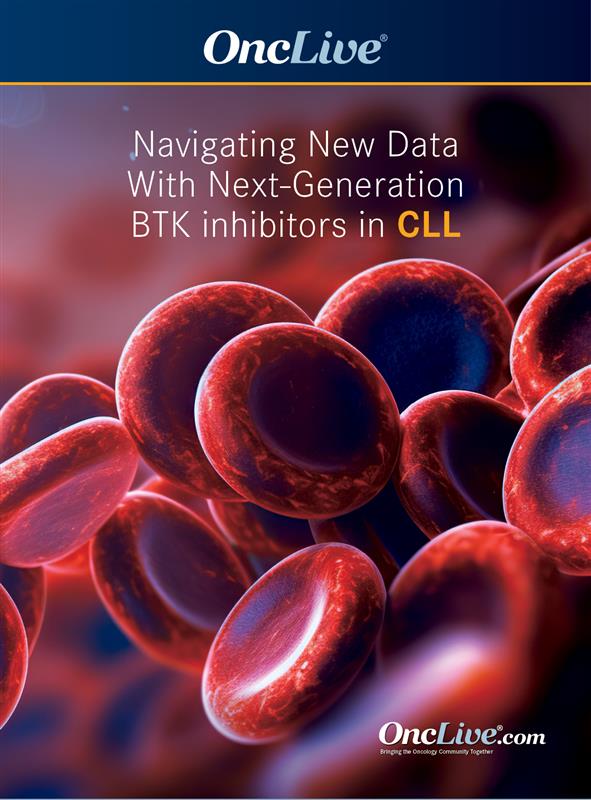News
Article
Supplements and Featured Publications
Acalabrutinib With or Without Obinutuzumab Provides Sustained PFS Benefit in Previously Untreated CLL
Author(s):
Acalabrutinib, as monotherapy or in combination with obinutuzumab, continued to improve progression-free survival vs obinutuzumab and chemotherapy in patients with treatment-naive chronic lymphocytic leukemia, regardless of genomic marker status.
Jeff P. Sharman, MD

Acalabrutinib (Calquence), as monotherapy or in combination with obinutuzumab (Gazyva), continued to improve progression-free survival (PFS) vs obinutuzumab and chemotherapy in patients with chronic lymphocytic leukemia (CLL), regardless of genomic marker status, according to 6-year follow-up data from the phase 3 ELEVATE-TN trial (NCT02475681) presented during the 2023 ASH Annual Meeting.
“Acalabrutinib-containing regimens led to improved PFS over controlled obinutuzumab plus chlorambucil. The addition of obinutuzumab to acalabrutinib resulted in improved response rates and PFS compared to acalabrutinib monotherapy,” Jeff P. Sharman, MD, who is the director of research at Willamette Valley Cancer Institute in Oregon, as well as the medical director of hematology research at The US Oncology Network, said during a presentation of the data.
“Obtaining a complete response with acalabrutinib-containing regimens leads to improved PFS and the safety of acalabrutinib regimens in treatment naive-CLL remains consistent with prior reports.”
Compared with the obinutuzumab-chlorambucil regimen, acalabrutinib plus obinutuzumab (median PFS, not reached [NR]); HR, 0.14; 95% CI, 0.10-0.20; P < .001) and acalabrutinib monotherapy (median PFS, NR; HR, 0.24; 95% CI, 0.17-0.32; P <.001) demonstrated superior PFS.
Similarly, the use of acalabrutinib, in combination and monotherapy, induced significantly higher overall response rates (ORRs; difference, 6.1%; 95% CI, 0.9%-11.4%; P = .022) and complete response (CR) rates (difference, 17.9%; 95% CI, 8.8%-27.0%; P = .022). Patients treated with acalabrutinib who experienced CR/complete remission with incomplete count recovery (CRi) had reduced risk for disease progression by 77% (HR, 0.23; 95% CI, 0.12-0.42; P < .001).
When stratified by IGHV status, the addition of acalabrutinib to obinutuzumab (median PFS, NR; HR, 0.08; 95% CI, 0.05-0.12; P < .001) as well as the monotherapy (median PFS, NR; HR, 0.12; 95% CI, 0.08-0.18; P < .001), continued to show superior PFS compared with the obinutuzumab-chlorambucil regimen (median PFS, 22.2 months).
When stratified by del(17p)/TP53 mutation status, the 6-year PFS rates for the acalabrutinib-obinutuzumab and acalabrutinib monotherapy arms were 56% (HR, 0.28, 95% CI, 0.13-0.59; P = .0009) and 56% (HR, 0.23; 95% CI, 0.10-0.52; P = .0002), respectively, compared with 18% in the obinutuzumab-chlorambucil arm.
In the crossover portion of the study, those in the acalabrutinib monotherapy group who went on to receive acalabrutinib plus obinutuzumab demonstrated a 6-year PFS rate of 62% (median PFS, NR), while the obinutuzumab-chlorambucil arm who crossed over achieved a 6-year PFS rate of 54% (median PFS, NR).
Overall survival was not reached in any treatment arm; however, the combination use of acalabrutinib plus obinutuzumab reduced the risk for death by 38% compared with obinutuzumab plus chlorambucil (HR, 0.62; 95% CI, 0.39-0.97; P = .0349).
Adverse events (AEs) of interest were similar in both acalabrutinib-containing arms, Sharman noted, adding that the incidence of cardiac-related AEs remained low at the 6-year follow-up.
The most common grade 3 or higher AEs in the acalabrutinib-obinutuzumab and acalabrutinib monotherapy arms were diarrhea (6.2% vs 0.6%, respectively), headache (1.1% vs 1.1%), arthralgia (2.2% vs 1.1%), neutropenia (30.9% vs 11.7%), fatigue (2.2% vs 1.1%), cough (0.6% vs 0.6%), COVID-19 (9.0% vs 7.3%), thrombocytopenia (8.4% vs 3.4%), pneumonia (7.3% vs 6.1%), hypertension (4.5% vs 5.0%), and syncope (5.1% vs 2.2%).
ELEVATE-TN Trial
In the randomized, controlled phase 3 trial, patients were randomized 1:1:1 to receive either 100 mg acalabrutinib twice daily plus a fixed duration of obinutuzumab for 6 cycles, 100 mg acalabrutinib monotherapy twice daily, or a fixed duration of obinutuzumab for 6 cycles plus a fixed duration of chlorambucil. Crossover from the obinutuzumab-plus-chlorambucil arm was allowed after independent review committee-confirmed progression.
Key inclusion criteria were comprised of age 65 years or older, or patients aged 18 to 65 who had a creatinine clearance of 30 to 60 mL/min and a CIRS-G score of more than 6; treatment-naive CLL requiring treatment per the iwCLL 2008 criteria; and an ECOG performance status score of 2 or less. Patients were excluded from the trial if they had significant cardiovascular disease.
Patients in the trial were stratified by del(17p) status, ECOG performance score, and geographic region.
Comparing PFS of both combination regimens served as the primary end point of the trial. Secondary end points included comparing PFS of acalabrutinib monotherapy vs obinutuzumab plus chlorambucil, investigator-assessed PFS, ORR, time to next treatment, undetected minimal residual disease, and safety.
Patients in the acalabrutinib-obinutuzumab, acalabrutinib monotherapy, and obinutuzumab-chlorambucil arms were a median age of 70 (range, 41-88), 70 (range, 44-87), and 71 (range, 46-91), respectively; the majority had an ECOG performance score of 0 to 1 (94.4% vs 92.2% vs 94.4%); and 9.5%, 8.9%, and 9.6% had del(17p).
Previous long-term follow-ups at 28.3 months, 46.9 months, and 58.2 months also demonstrated superior efficacy and acceptable tolerability with acalabrutinib plus obinutuzumab compared with obinutuzumab plus chlorambucil, Sharman said.
In the 6-year follow-up, median study follow-up in the acalabrutinib-obinutuzumab, acalabrutinib monotherapy, and obinutuzumab-chlorambucil arms was 74.6 months (range, 1.7-89.0), 74.5 months (range, 0.1-88.8), and 73.3 months (range, 0.0-88.8), respectively. Overall, 96 patients in the acalabrutinib-obinutuzumab group (53.6%) and 84 patients in the acalabrutinib monotherapy group (46.9%) are ongoing with treatment, while no patients are receiving the obinutuzumab-chlorambucil regimen. Seventy-nine patients (44.6%) crossed over from receiving obinutuzumab plus chlorambucil to the acalabrutinib-obinutuzumab combination.
Reference
Sharman JP, Egyed M, Jurczak W, et al. Acalabrutinib ± Obinutuzumab Vs Obinutuzumab + Chlorambucil in Treatment-Naive Chronic Lymphocytic Leukemia: 6-Year Follow-up of Elevate-TN. Blood. 2023; 142(1):636. doi:10.1182/blood-2023-174750










